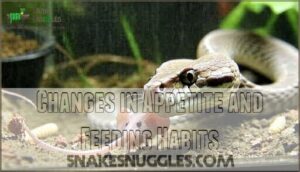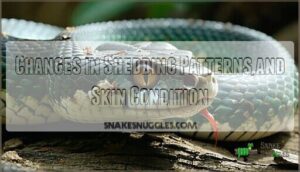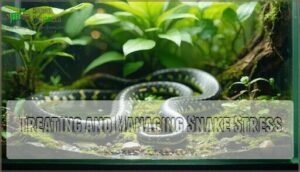This site is supported by our readers. We may earn a commission, at no cost to you, if you purchase through links.

Look for red flags: refusing meals, odd shedding patterns, excessive hiding, or sudden aggression.
Your snake might also display unusual body language, like constant tail-twitching or defensive posturing.
Environmental culprits often include wrong temperatures, poor humidity, or cramped quarters.
Handling stress shows up as striking during routine interactions or withdrawal from normal activities.
Quick fixes involve checking your husbandry basics—temperature gradients, hiding spots, and feeding schedules.
Think of stress management as creating your snake’s perfect sanctuary, where everything feels just right, with proper temperature gradients, adequate hiding spots, and a well-planned feeding schedule to reduce stress.
Table Of Contents
- Key Takeaways
- Identifying Snake Stress
- Environmental Factors Affecting Stress
- Dietary Factors and Stress
- Handling and Interaction Stress
- Treating and Managing Snake Stress
- Frequently Asked Questions (FAQs)
- How to tell if a snake is stressed when handling?
- How to reduce stress in reptiles?
- What can stress do to a snake?
- Can snake stress influence shedding patterns significantly?
- What are the common long-term effects of stress?
- How does stress impact snake reproduction rates?
- Is stress-related illness prevalent in captive snakes?
- Can stress cause permanent health damage in snakes?
- How long does snake stress recovery typically take?
- Can stressed snakes transmit illness to other pets?
- Conclusion
Key Takeaways
- Watch your snake’s behavior closely – refusal to eat, odd shedding patterns, excessive hiding, or sudden aggression are clear stress signals you cannot ignore
- Check your husbandry basics first – wrong temperatures, poor humidity, cramped quarters, and inadequate hiding spots are the most common stress triggers you will need to fix
- Handle with care and respect boundaries – limit sessions to 15-30 minutes, use gentle support techniques, and back off when your snake shows defensive posturing or escape attempts
- Create a stress-free sanctuary – provide multiple hiding spots, maintain consistent temperature gradients, reduce noise and vibrations, and stick to regular feeding schedules for optimal snake wellbeing
Identifying Snake Stress
Your snake’s behavior tells you everything you need to know about their stress levels—you just need to know what to look for.
Think of stress signs like your snake’s way of sending you a text message, except instead of words, they use changes in appetite, unusual body language, shedding problems, hiding habits, and defensive reactions.
Your snake speaks stress through body language—learn to read their silent signals.
Changes in Appetite and Feeding Habits
Monitoring appetite changes reveals critical stress indicators in your snake.
Refusal to eat often signals environmental distress, while food regurgitation indicates handling errors.
Weight loss accompanies prolonged feeding issues, requiring immediate attention.
Picky eating and increased hunger also suggest underlying stressors affecting normal feeding patterns.
- Your snake’s empty food bowl might hide a cry for help
- Weight loss creeps in silently, threatening your pet’s health
- Regurgitated meals create messy reminders of stress overload
- Picky eating habits mirror your snake’s inner turmoil
- Sudden food obsession reveals desperate attempts to self-soothe
Unusual Posturing and Body Language
When your snake’s body language screams "something’s wrong," you’re witnessing stress in real-time.
Watch for head cocking, body flattening, and tail twitching – classic snake stress symptoms that signal distress. Tight coiling and excessive tongue flicking beyond normal exploration reveal anxiety levels rising.
These unusual posturing behaviors are your snake’s way of saying "help me feel safe again."
| Defensive Postures | Stress Indicators |
|---|---|
| Head cocking, body flattening, tight coiling | Tail twitching, excessive tongue flicking |
Recognizing snake stress through body language helps you address problems before they escalate into serious health issues.
Changes in Shedding Patterns and Skin Condition
Three shedding problems can reveal your snake’s stress levels and overall health status.
When dysecdysis occurs, your snake’s skin comes off in patches instead of one complete piece. This irregular shedding pattern indicates environmental stressors like improper humidity levels or temperature fluctuations affecting your pet’s comfort.
To assist with this process, owners can increase enclosure humidity to facilitate shedding.
Watch for these key shedding stress signs:
- Retained shed around eyes and tail that won’t come off naturally
- Skin discoloration appearing dull, faded, or abnormally colored between sheds
- Scale abnormalities including wrinkled, damaged, or missing scales after shedding
- Shedding frequency changes – either too often or delayed cycles lasting months
Increased Hiding and Withdrawal
Recognizing increased hiding signals your snake’s security needs aren’t met.
While snakes naturally seek hiding places, excessive withdrawal indicates snake stress.
Behavioral changes like reduced activity and constant comfort seeking require immediate enclosure assessment.
Monitor duration and frequency of hiding behavior.
Persistent snake anxiety often stems from inadequate hides, temperature issues, or environmental disturbances affecting their sense of safety.
Aggressive Behavior and Striking
Defensive behavior isn’t just attitude—it’s your snake’s alarm system signaling discomfort or threat perception. Striking represents a last resort when other stress signals go unnoticed.
- Practice gentle handling techniques to minimize handling discomfort and reduce aggressive behavior episodes.
- Identify defensive signals early like tight coiling or hissing before escalation to striking occurs.
- Implement trigger avoidance strategies by removing stressors that cause snake handling stress reactions.
Environmental Factors Affecting Stress
Your snake’s environment acts like a thermostat for stress – when conditions are off, your pet’s anxiety skyrockets.
Your snake’s home is their stress meter—get the environment wrong, and watch anxiety levels soar.
Temperature, humidity, lighting, space, and even background noise all play vital roles in keeping your serpent calm and comfortable**.
Temperature and Humidity Levels
Getting temperature and humidity wrong is like serving your snake a cold dinner—they won’t appreciate it.
Ideal Ranges for most species fall between 75-85°F with 50-60% humidity.
Gradient Importance can’t be overstated; create distinct warm and cool zones using Monitoring Tools like digital thermometers and hygrometers.
Misting Systems help maintain consistent snake humidity levels, while Seasonal Adjustments prevent snake stress.
For corn snakes, it’s important to maintain a basking temperature of 90°F.
Check readings daily and adjust accordingly.
Lighting and Photoperiod
Proper lighting and photoperiod control prevents snake stress by mimicking natural patterns.
UVB importance varies by species—some need it, others don’t. Nocturnal lighting should be minimal; red bulbs work well.
Natural mimicry means 12-hour day/night cycles for most species. Photoperiod duration affects breeding cycles and appetite.
Consistent lighting schedules reduce environmental stress and support healthy snake wellbeing. For ideal health, consider that color temperature matters and should aim for 5000K-6500K for daytime lighting.
Enclosure Size and Layout
Your snake’s enclosure size directly impacts stress levels—cramped spaces create anxious reptiles.
Adequate territory size allows natural behaviors while preventing the trapped feeling that triggers defensive responses.
Many factors contribute to proper habitat dimensions.
Essential enclosure considerations:
- Territory Size: Minimum length equals snake’s body length for ground-dwelling species
- Vertical Space: Climbing opportunities reduce stress in arboreal and semi-arboreal species
- Hiding Variety: Multiple secure retreats throughout different temperature zones
- Enrichment Items: Branches, plants, and textured surfaces encourage exploration
- Environmental Enrichment: Strategic layout prevents monotony and promotes mental stimulation
Substrate and Decorations
Around your snake’s world, natural substrates like cypress mulch create comfort while textured substrates encourage natural behaviors.
Add hiding variety with cork bark and artificial plants for visual appeal.
Include branches for climbing enrichment – your snake will thank you for the workout!
Appropriate bedding options contribute to a healthy habitat.
Choose safe materials that won’t splinter or harbor bacteria, turning their snake enclosure into a stress-free sanctuary.
Noise Levels and Vibrations
Environmental noise and vibrations create significant auditory stressors for snakes.
Vibration sources like stereos, televisions, or foot traffic transmit through enclosure materials, mimicking predator threats.
Strategic placement away from high-traffic areas reduces snake noise stress.
Soundproofing enclosures with foam padding or relocating tanks to quieter rooms minimizes environmental stressors.
Your snake’s noise sensitivity means even minor vibrations can trigger chronic stress responses.
Dietary Factors and Stress
You mightn’t realize it, but what you feed your snake and how you feed them can trigger stress responses that affect their overall health.
Poor nutrition, irregular feeding schedules, and improper prey choices create a cascade of problems that manifest as behavioral changes and physical symptoms, ultimately leading to a decline in the snake’s well-being due to poor nutrition.
Nutritional Deficiencies and Imbalances
Poor nutrition hits snakes like a hangover hits you after too many drinks.
Calcium deficiency causes metabolic bone disease, while vitamin A shortages trigger respiratory infections.
Nutritional deficiencies stress your snake’s immune system, making illness likely.
Vitamin supplementation helps fish-eating species avoid thiamine problems.
Prey variety and proper hydration importance maintain your snake’s balanced diet, preventing costly vet visits.
Feeding Frequency and Schedule
Feeding your snake on consistent schedules reduces anxiety and promotes healthy digestion.
Weekly feedings work well for most adult snakes, though juveniles need more frequent meals.
Here’s what matters for stress-free feeding:
- Stick to regular intervals – your snake thrives on predictability, like clockwork
- Respect natural brumation fasting – don’t panic when appetite drops seasonally
- Avoid overfeeding risks – bloated snakes become lethargic and stressed
- Wait appropriate intervals between meals to prevent regurgitation causes
- Monitor for stress-related feeding issues – sudden appetite changes signal problems
Prey Item Size and Type
Selecting the right prey size and type directly impacts your snake’s stress levels and overall health. Appropriate Size matters most—prey should create a visible bulge without causing Digestion Issues or regurgitation.
Whole Prey provides complete Nutritional Content that processed alternatives can’t match. Prey Variety prevents dietary boredom and guarantees balanced nutrition.
Here’s what works best:
- Choose prey 10-15% of your snake’s body weight
- Offer different species (mice, rats, chicks) when possible
- Stick to pre-killed frozen prey for safety
- Monitor feeding responses for stress-related feeding issues
Proper prey item size reduces snake feeding stress substantially.
Water Quality and Availability
Beyond proper prey selection, your snake’s water quality directly impacts stress levels and overall health.
Clean, filtered water prevents waterborne diseases that can compromise your pet’s immune system.
Water filtration systems remove chlorine and other chemicals that stress reptiles, while regular water changes every 3-5 days eliminate bacterial buildup.
Monitor humidity control through proper water placement – shallow dishes work best for most species.
Snake hydration needs vary, but all require consistent access to fresh water.
Temperature matters too; room-temperature water feels most natural to your snake environment.
fresh water always
maintenance
Supplements and Vitamins
Proper nutrition supports your snake’s well-being beyond basic feeding.
Calcium supplementation and vitamin A prevent metabolic disease when administered at the proper dosage. Reptile-specific supplements address nutritional deficiencies that disrupt your snake’s balanced diet.
Quality snake vitamins contain essential nutrients like vitamin D3 and B-complex. Vitamin D3 aids absorption of calcium, which is essential for preventing metabolic bone disease.
Store supplements properly and consult your veterinarian for species-specific recommendations.
Handling and Interaction Stress
You’ll quickly discover that how and when you handle your snake plays a major role in their stress levels.
Think of handling like a delicate dance – too much pressure or the wrong moves, and your snake will let you know they’re not enjoying the performance.
Handling Frequency and Duration
Managing snake handling frequency requires a measured approach. Like scheduling coffee dates, timing matters for snake interaction.
Limit sessions to 15-30 minutes to prevent stress buildup, adjusting for your snake’s temperament and age. Handling limits that respect boundaries:
- Young snakes need shorter, gentler sessions
- Adult snakes tolerate longer interaction periods
- Weekly handling maintains trust without overwhelming
Proper snake handling techniques emphasize support balance during social interaction, recognizing that interaction stress increases with excessive contact.
Recognizing and responding to defensive snake postures can help minimize stress during handling, which is crucial for maintaining a healthy and trustful relationship with your snake.
Handling Techniques and Restraint
When handling your snake, think of it like a dance—smooth moves prevent stress.
Gentle support and proper restraint keep both you and your snake comfortable during interactions.
- Support the entire body: Cradle your snake securely to prevent the falling sensation that triggers fear responses
- Use slow, deliberate movements: Quick gestures mimic predator attacks and spike stress levels immediately
- Apply minimal restraint: A secure embrace without excessive pressure maintains control while respecting boundaries
Support and Confinement
Your snake needs body support, not tight gentle restraint. Think of offering a floating pool noodle rather than a bear hug – secure embrace without squeezing.
This handling comfort prevents the falling sensation that triggers snake stress.
| Support Method | Comfort Level | Stress Reduction |
|---|---|---|
| Two-handed cradle | High | Maximum |
| Single-hand grip | Low | Minimal |
| Balanced support | Ideal | Reducing snake stress |
Proper support becomes your best calming techniques for snake anxiety relief.
Interaction With Other Snakes
While proper support reduces physical stress, snake social stress presents unique challenges.
Most solitary species become anxious when housed together, displaying dominance displays like wrestling or defensive coiling.
Cohabitation risks include chronic stress from territorial disputes and resource competition.
Breeding stress intensifies during mating seasons.
Implement strict quarantine protocols before introductions and monitor for escape attempts or aggressive posturing—clear signs your scaly friends need separate apartments.
Human Interaction and Socialization
Your snake’s social needs vary wildly—some tolerate gentle handling while others prefer solitude.
Respect your snake’s boundaries by observing stress signals and tailoring interactions accordingly. Trust building requires consistent gentle approach and noise avoidance for effective stress management.
- Whisper-quiet voices during handling sessions
- Slow, deliberate movements mimicking gentle breezes
- Consistent daily observations without intrusion
- Respectful retreat when snake shows discomfort
Treating and Managing Snake Stress
Once you’ve identified stress in your snake, treating it requires targeted interventions that address the root causes rather than just the symptoms.
The key is creating an environment that mimics your snake’s natural habitat while eliminating stressors through systematic adjustments to housing, diet, and handling practices, which is crucial for reducing stress.
Environmental Enrichment and Modification
Creating the right environmental enrichment transforms your snake’s habitat from boring box to behavioral paradise.
Enclosure complexity matters—add multiple levels, branches for climbing opportunities, and varied textures for sensory stimulation.
Naturalistic design with live plants, rock formations, and water features reduces snake environmental stress dramatically.
You can find ideas for snake habitat products to enhance your snake’s environment.
These enclosure conditions promote behavioral variety, letting your snake express natural instincts while feeling secure and engaged.
Dietary Changes and Supplements
**Adjusting your snake’s diet can dramatically reduce stress levels.
**Address nutritional deficiencies with calcium and vitamin D3 supplements, guaranteeing proper dosages to prevent toxicity.
**Feeding variety through different prey types improves nutrient absorption and prevents dietary boredom.
**Maintain consistent feeding schedules while monitoring hydration importance through fresh water availability.
**Quality snake supplements support recovery during stressful periods, but avoid overfeeding to prevent obesity.
**To guarantee proper bone health, consider calcium and phosphorus balance.
Handling and Interaction Adjustments
When handling becomes overwhelming for your snake, gentle techniques make all the difference.
Limit handling frequency to 15-20 minutes and provide secure support for their entire body.
Respect boundaries by avoiding sudden movements and loud noises.
Monitor social dynamics carefully—your snake’s body language reveals stress levels.
Think of proper handling practices as building a friendship where trust grows through consistent, calm interactions that prioritize your snake’s comfort over convenience.
Providing Hiding Places and Visual Barriers
Your snake needs secure retreats that feel like personal fortresses.
Place at least two hiding spots — one warm, one cool — using snug-fitting boxes, caves, or commercial hides.
Add visual barriers like plants or decorations to reduce exposure and create enclosure density.
These hiding materials provide essential visual security, dramatically improving snake stress relief when your pet feels vulnerable.
Reducing Stress Through Observation and Monitoring
Once you’ve provided adequate hiding spots, behavioral baselines become your roadmap for early detection of stress indicators.
Document daily patterns through routine monitoring and record keeping—like a detective tracking clues.
Watch for changes in feeding schedules, movement patterns, and hiding preferences during environmental assessment.
This stress observation approach helps you spot signs of stress before they escalate, making snake stress monitoring as predictable as clockwork.
Frequently Asked Questions (FAQs)
How to tell if a snake is stressed when handling?
Like reading a serpent’s body language, you’ll notice rapid tongue-flicking, defensive striking, tight coiling, escape attempts, or sudden stillness when your snake feels threatened during handling sessions.
How to reduce stress in reptiles?
Maintain proper temperatures and humidity levels, provide multiple hiding spots, minimize handling frequency, guarantee adequate space, reduce noise and vibrations, offer consistent feeding schedules, and create secure environments.
What can stress do to a snake?
Chronic stress wreaks havoc on your snake’s immune system, making them vulnerable to respiratory infections, parasites, and metabolic disorders that can become life-threatening.
Can snake stress influence shedding patterns significantly?
Yes, stress dramatically affects your snake’s shedding patterns. You’ll notice dysecdysis (incomplete shedding), retained pieces, discolored skin, and irregular timing. Stressed snakes often struggle with the natural process.
What are the common long-term effects of stress?
While short-term stress might seem manageable, chronic stress devastates your snake’s health.
You’ll notice suppressed immunity, metabolic disorders, digestive issues, shortened lifespan, and behavioral changes that persist long after stressors disappear.
How does stress impact snake reproduction rates?
Stress disrupts your snake’s reproductive hormones, reducing breeding success and fertility rates. Chronically stressed females may skip breeding cycles entirely, while males show decreased sperm quality and mating behaviors.
Is stress-related illness prevalent in captive snakes?
Like a silent storm brewing beneath calm waters, stress-related illness runs rampant in captive snakes.
You’ll find it’s surprisingly common—poor husbandry, inadequate environments, and handling mishaps create a perfect recipe for compromised immune systems and various health complications, leading to stress-related illness.
Can stress cause permanent health damage in snakes?
Chronic stress absolutely damages your snake’s health permanently. It suppresses their immune system, disrupts digestion, causes metabolic disorders, and can lead to organ failure if left untreated.
How long does snake stress recovery typically take?
Like healing from a broken heart, your snake’s recovery timeline varies widely.
Mild stress resolves within days to weeks with proper care, while severe chronic stress may require months of consistent environmental improvements.
Can stressed snakes transmit illness to other pets?
Yes, stressed snakes can potentially transmit illnesses to other pets.
Chronic stress weakens their immune system, making them more susceptible to infections that could spread through shared environments or indirect contact.
Conclusion
Successfully recognizing and treating snake stress requires consistent observation and swift environmental adjustments.
When you notice behavioral changes like appetite loss or defensive posturing, don’t panic—most stress issues resolve with proper husbandry corrections.
Check your temperature gradients, humidity levels, and hiding spots first.
Remember, your snake can’t tell you what’s wrong, so becoming fluent in their body language is essential.
With patience and the right approach, you’ll create the perfect stress-free environment your serpent companion deserves, using proper husbandry corrections.
- https://ball-pythons.net/forums/showthread.php?221255-Signs-of-Comfort-and-Stress-in-Snakes
- https://www.youtube.com/watch?v=5fInqG6tP3c
- https://aminoapps.com/c/reptiles/page/item/stress-in-ball-pythons-and-how-to-prevent-it/z6gj_gV4hwIY6r14EBL6pJzZDDrvoZ8kJ73
- https://www.behavioreducation.org/post/minimizing-transition-stress-for-snakes-a-guide-to-low-stress-home-and-habitat-changes
- https://www.reddit.com/r/cornsnakes/comments/khqw1i/how_can_i_help_my_stressed_snake/



















